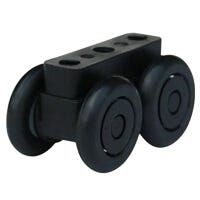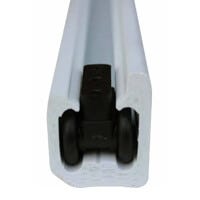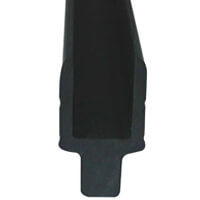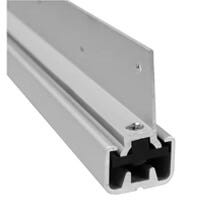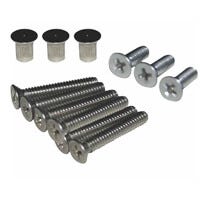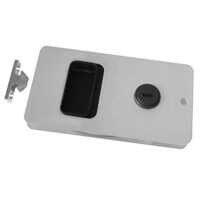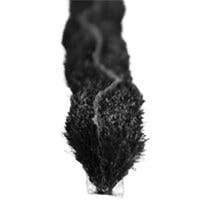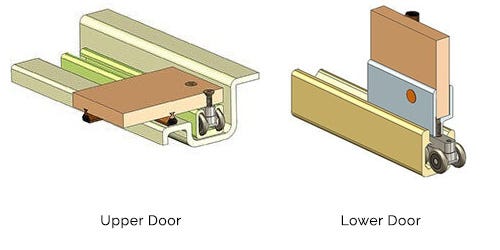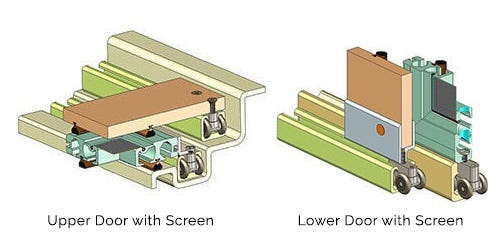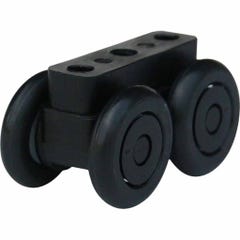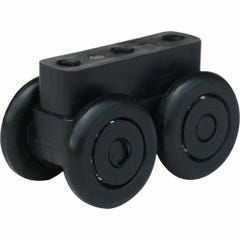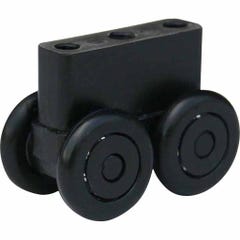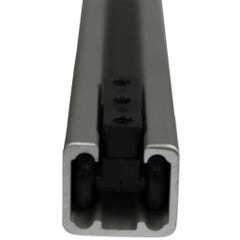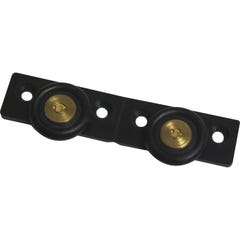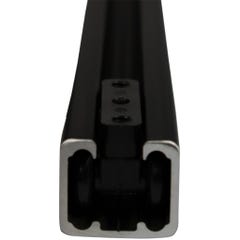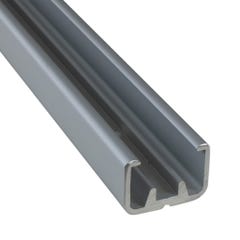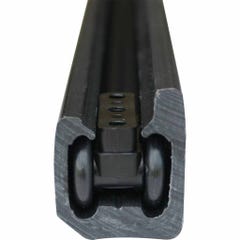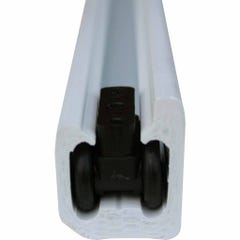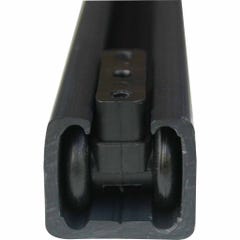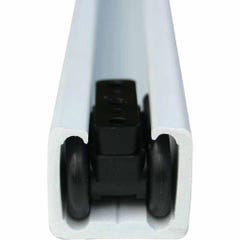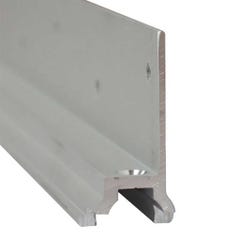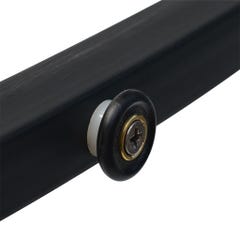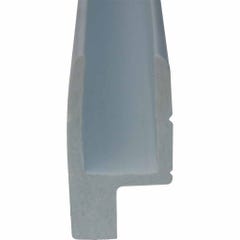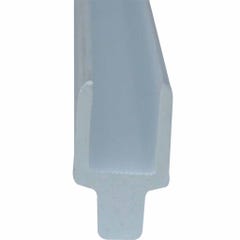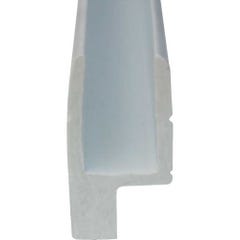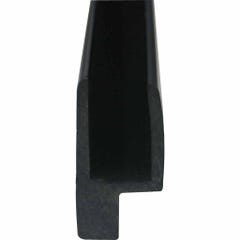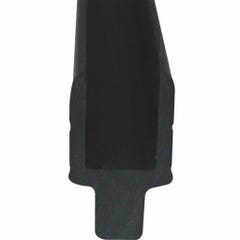Marine Sliding Door Hardware
Sliding doors are a great option on most boats. Whether installing a new door or replacing hardware like tracks, trucks, carriers, glides, or latches on an existing door, Boat Outfitters has all the parts you might need. » Read More
Typical Sliding Door Hardware Setups
Learn More About Sliding Door Hardware
Contents
Benefits of Sliding Doors for Your Boat
Sliding doors have a lot of benefits when compared to other types of doors on a boat. They aren’t feasible for all boats, but when possible, they have more pros than cons. Like anything else on a boat, your usage and location are important. Sliding doors are especially useful for narrow areas without enough clearance for a traditional single-leaf hinged door. They’re useful in tight pilothouses and narrow access ways where different doors might not be able to open completely. Read More
Sliding doors function by opening parallel to the wall they’re mounted on. Instead of swinging out on hinges like a normal door, the door moves sideways on sliding tracks. Most marine sliding doors are one single panel, but on some larger cruising vessels or sportfishers they can be multiple panels. Since they slide parallel to the wall, they take up very little space when open. Since they don’t swing out, there’s no risk of them bumping into helm chairs or other parts of your boat.
The construction of sliding doors is fairly simple. Instead of putting all of the stress along one area like a hinged door, it distributes the weight evenly amongst different parts of the door frame. The hardware slides within the tracking, opening, or closing of the door. A latch then secures the door when closed. Hardware can also be installed to hold a door open when more airflow is desired. The latch of a sliding door used on a boat should consist of marine-grade components. All of the latches offered by Boat Outfitters have locking mechanisms for increased security.
Types of Sliding Door Hardware
There are two main types of hardware for sliding doors. The only difference is what the door slides on; the functionality should be the same. Regardless of what kind of sliding door you use, your door should slide smoothly.
The first system is the “track and truck” system. This system involves a slotted track with small-wheeled “trucks” riding inside of them. Trucks are available in different sizes. Most trucks are made from marine grade plastic with stainless steel ball bearings for the four wheels and measure either .885”, .975”, or 1/2” in height. Read More
Marine sliding tracks are usually made from either aluminum or marine-grade plastic. Both upper and lower tracks typically measure 1-1/8” wide, but lower tracks are taller — 1-1/2” vs. 1” for upper tracks.
Track and truck sliding doors also normally use a “train,” which fits over the edges of the door panel and fastens to the truck. Trains are either “inline,” meaning that the truck is in the middle of the door panel, or “offset,” which places the truck closer to one side of the door panel.
The other common marine sliding track system is the “roller ball” system. This system has the door sliding on two plastic balls at the bottom and glide rails at the top.
The track and truck system is more common, but the roller ball system is more appropriate for heavy-duty doors that are thicker than half an inch. Besides being more common, the track and truck system is typically smoother, but again, it’s geared toward lightweight marine doors. Both systems are easily customizable. All the parts required for assembly can be bought at Boat Outfitters, and the rail can be cut to a size specific to your needs.
Sliding Door Materials
All of the items that are on your boat need to be marine grade. Your doors and hardware should have stainless steel components where metal is required, and the rest should be marine-grade plastic. High-density marine-grade plastic is durable and corrosion-resistance but can wear over time, and require those components to be replaced. Some sliding tracks are available in aluminum, which stands up to wear longer than plastic. Read More
Different sliding doors may require different materials. A simple sliding door on your electronics box will only require thin acrylic to protect your devices. On a small center console access hatch, the door material might be thick starboard, much heavier than the acrylic used for the electronics box. Doors to living areas or pilot houses should be fairly heavy. They need to be able to provide adequate protection to all occupants and protect the living areas from the elements.
Sliding Door Latches
The latches on sliding doors differ from those on most other boat doors in that they must be very low profile to allow the door to fully retract. Most mount in a rectangular cutout at the edge of the door panel and use an “arrowhead” style catch on the frame or jamb. Sliding door latches on boats are usually made from either aluminum or stainless steel. White and black sliding latches are powder-coated aluminum.
Other Sliding Door Parts
Many sliding doors — especially cabin entry doors — use so-called hairy fin seals to help keep out the elements. These can wear out over time, and replacements can be difficult to find. Fin seals are made to fit into a certain size of kerf — or slot — with .187” being the most common.
Replacing tracks and trucks on boat sliding doors often requires specialized fasteners, including flush barrel nuts. The easiest choice when replacing trucks is to purchase a fastener kit that includes everything you need to replace upper and lower trucks. For a more finished look, choose a kit with flush nuts that match the color of your door, whether white, black, or chrome.
Sliding Door Dampers
Sliding doors do have one significant drawback worth mentioning. In rough seas, they can slide open and closed rapidly as the boat rolls. This can pose a safety hazard, including having fingers pinched in the door. To negate this, door dampers can slow down the door, reducing its momentum. In most cases, a door damper is some version of a gas shock. It uses compressed gases or fluids to slow the door from slamming shut. Be sure to keep some sort of damper system in mind when you’re designing your door. Read More
Remember that anytime you’re shopping to replace your old hardware or just installing a new one, Boat Outfitters has you covered for all your boating needs.
Installing Sliding Door Hardware
How you install your hardware depends on a few things. First, you need to identify what style of sliding hardware you have. If you have the track and truck system you need to confirm whether it is an old-style or a new-style track. The old style was used before 1997, while the newer style wasn’t switched over until 2000. Any years between 1997 and 2000 could have used either, so it’s important to know the difference. Old-style trucks can work in new-style tracks, but not vice-versa. Regardless, we recommend replacing old-style trucks, which are prone to failure. Read More
Once you decide on the specifics of your sliding door system, measure how much track you need, and order all of your parts. Tracking installation doesn’t require any special tools and the tool list only consists of Philips head screwdrivers, a drill, and a hacksaw. Cut your tracking down to the same length as the original, and use the same mounting holes as the original as well. Remember to use stainless steel hardware and seal your holes. If you don’t, moisture could find its way into your coring, resulting in costly repairs down the road.
See our helpful sliding door track FAQs for more detailed information.
Contact Us
If you’re having trouble finding the exact part you're looking for, the best first step is to take a picture and give us a call.
Our customer service team is here Mon-Fri 8am - 5pm and would love to help you track down the exact hardware you need.

Need Help?
Speak to one of our industry pros:
Tap to Call
Commonly Asked Questions About Sliding Door Hardware
Sliding door components for boats are fairly specialized and surprisingly difficult to find. Boat Outfitters stocks a carefully chosen selection that is compatible with the sliding doors on most makes and models of recreational boats. You can also try calling your boat dealer or manufacturer.
Southco manufactures a variety of quality sliding door latches in aluminum and stainless steel. Southco latches are available from Boat Outfitters.
Any track and truck door manufactured before 1997 is old-style. Any door system manufactured in 2000 or more recently uses the new style. Model years 1997, 1998, and 1999 could be either. Look at the end of your track in the cross-section. If one side is taller than the other, you have a new style. If the sides are the same height, you have old style.
To replace the bottom track and tracks, you’ll have to remove the bottom of the door from the train, but you don’t necessarily need to remove it completely. To replace top tracks and trucks, assuming you have access to the screws holding the trucks in place, you don’t need to disassemble anything else.

